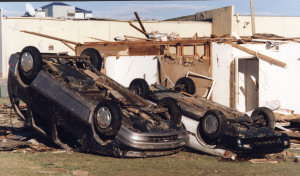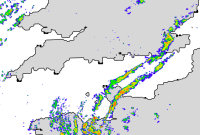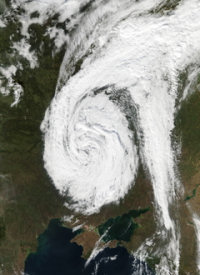Mesoscale and Synoptic-Dynamic Meteorology

The focus of our research group is improved understanding of the physical processes responsible for weather systems on the synoptic scale and mesoscale. These weather systems include extratropical cyclones, fronts, mesoscale convective systems, tropical cyclones, polar lows, and orographic precipitation. As these weather systems can be potentially hazardous through their production of flash flooding, heavy snow, lightning, tornadoes, hail or damaging wind, our group also studies the processes and mechanisms responsible for these impacts.
We use a variety of approaches to accomplish these goals.
Data from the operational global observing system serves as a valuable tool to formulate and test hypotheses for how weather systems work. Our group has employed upper-air soundings, surface stations, satellite and radar in our studies.
Climatologies provide a way to assess the frequency of weather events and to examine the common synoptic environments favorable for their formation. Our group has constructed climatologies of hazardous weather such as lightning, convective storms and tornadoes for the UK and Europe.

In collaboration with other research groups across the UK and the world, our group collects measurements from field programmes and experimental observing systems. Most recently, members of our group and PhD students flew on specially-instrumented meteorological research aircraft as part of the DIAMET (Diabatic influence on Mesoscale Structures in Extratropical Storms) field campaign. We also use data from the Mesosphere-Stratosphere-Troposphere wind-profiling radar at Aberystwyth to examine the structure of surface-based and upper-level fronts and their relationship to convective storms.

Members of our group are involved in modeling of real-data events and using simplified models of idealized weather systems using numerical weather prediction models such as WRF. Such modeling efforts have included the first diagnostic study of snowbands over the English Channel and Irish Sea during cold-air outbreaks, the study of wind and precipitation fields in idealized baroclinic waves, and precipitation in Arctic polar lows.
One of the most satisfying aspects of the outcome of our work is to help improve conceptual models for weather forecasters. Through our work with windstorms, convective systems, and fronts, we have provided training for forecasters on three continents. Moreover, articles deriving from our research are published in the highest-impact meteorological journals. For example, our research has led to revision of the 90-year-old conceptual model of how occluded fronts are formed (Schultz and Vaughan 2011, Bulletin of the American Meteorological Society). Students in our group are expected to begin writing their own research articles within their first or second year, helping to accelerate their maturation as a functioning member of the research community.
Our group also interacts with members of the remote-sensing group, aerosol-modeling research group, and cloud physics group, through our use and knowledge of meteorological data and numerical weather prediction models.